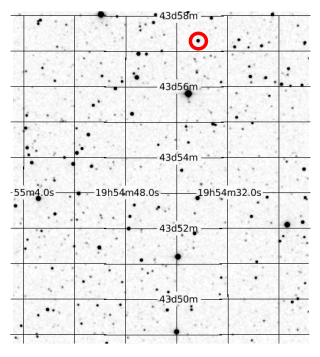Kepler-186
|
Star Kepler-186 |
|||||
|---|---|---|---|---|---|

|
|||||
| Image of the Two Micron All Sky Survey in the J-Band, Kepler-186 is the star in the red circle | |||||
| AladinLite | |||||
|
Observation dates equinox : J2000.0 , epoch : J2000.0 |
|||||
| Constellation | swan | ||||
| Right ascension | 19 h 54 m 36.65 s | ||||
| declination | + 43 ° 57 ′ 18 ″ | ||||
| Typing | |||||
| Known exoplanets | 5 | ||||
| Spectral class | M1 V | ||||
| Variable star type | BY | ||||
| Astrometry | |||||
| parallax | (5.60 ± 0.03) mas | ||||
| distance | (582 ± 3) ly (178) pc |
||||
| Proper movement | |||||
| Rec. Share: | (2.10 ± 0.04) mas / a | ||||
| Dec. portion: | (−4.36 ± 0.04) mas / a | ||||
| Physical Properties | |||||
| Dimensions | (0.544 +0.024−0.021) M ☉ | ||||
| radius | (0.523 +0.023−0.021) R ☉ | ||||
| Luminosity |
(0.055 ± 0.010) L ☉ |
||||
| Effective temperature | (3755 ± 90) K. | ||||
| Metallicity [Fe / H] | (−0.26 ± 0.12) | ||||
| Age | (4.0 ± 0.6) bill. A | ||||
|
Other names and catalog entries |
|||||
|
|||||
Kepler-186 is a red dwarf of spectral class M in the constellation Swan, almost 600 light years from Earth . It has about half the diameter of the sun and about half the mass of the sun, is slightly cooler than the sun and has a metallicity that is about a factor of 2 lower . Kepler-186 is also a BY Draconis star , the brightness of which fluctuates slightly over a period of 33.695 days.
Planetary system
Based on the observations made by the Kepler space telescope , the discovery of five planets orbiting this star was confirmed in spring 2014 . Among them is Kepler-186f, an earth-like planet that is in the habitable zone of Kepler-186 with an orbital period of 130 days . The planet has a radius about 11% larger than the earth .
The planets Kepler-186b, Kepler-186c, Kepler-186d and Kepler-186e, orbiting further inward, are each less than one and a half times the size of Earth and have an orbital period of 4, 7, 13 and 22 days and are considered too hot for that earthly comparable life.
The fastest man-made space probes yet, Helios 1 and 2, would take over two million years to cover the current distance between the solar system and Kepler-186.
|
Planet (by distance from the star) |
Discovery (year) |
Radius (in ) |
Cycle time (in days) |
Major semi-axis (in AU ) |
Orbit inclination (in ) |
eccentricity |
|---|---|---|---|---|---|---|
| Kepler-186b | 2014 | 1.07 ± 0.12 | 3.8867907 +0.0000062−0.0000063 | 0.0343 ± 0.0046 | - | - |
| Kepler-186c | 2014 | 1.25 ± 0.14 | 7.267302 +0.000012−0.000011 | 0.0451 ± 0.0070 | - | - |
| Kepler-186d | 2014 | 1.40 ± 0.16 | 13.342996 +0.000025−0.000024 | 0.0781 ± 0.010 | - | - |
| Kepler-186e | 2014 | 1.27 +0.15−0.14 | 22.407704 +0.000074−0.000072 | 0.110 ± 0.015 | - | - |
| Kepler-186f | 2014 | 1.17 ± 0.08 | 129.9441 +0.0013−0.0012 | 0.432 +0.171−0.053 | 89.96 +0.04−0.10 | > 0.04 +0.07−0.04 |
Individual evidence
- ↑ a b c d KOI-571. In: SIMBAD . Center de Données astronomiques de Strasbourg , accessed on September 3, 2018 .
- ^ Elisa V. Quintana, Thomas Barclay, Sean N. Raymond, et al .: An Earth-Sized Planet in the Habitable Zone of a Cool Star. Science, 344 (2014), 277, doi: 10.1126 / science.1249403
- ↑ a b The International Variable Star Index: KIC 8120608. Retrieved September 3, 2018 .
- ↑ a b c d e f g Kepler-186. In: NASA Exoplanet Archive . Retrieved September 3, 2018 .
- ↑ nasa.gov: NASA's Kepler Discovers First Earth-Size Planet In The 'Habitable Zone' of Another Star , accessed April 17, 2014
- ^ Nasa.gov: Kepler-186 and the Solar System , accessed April 17, 2014


